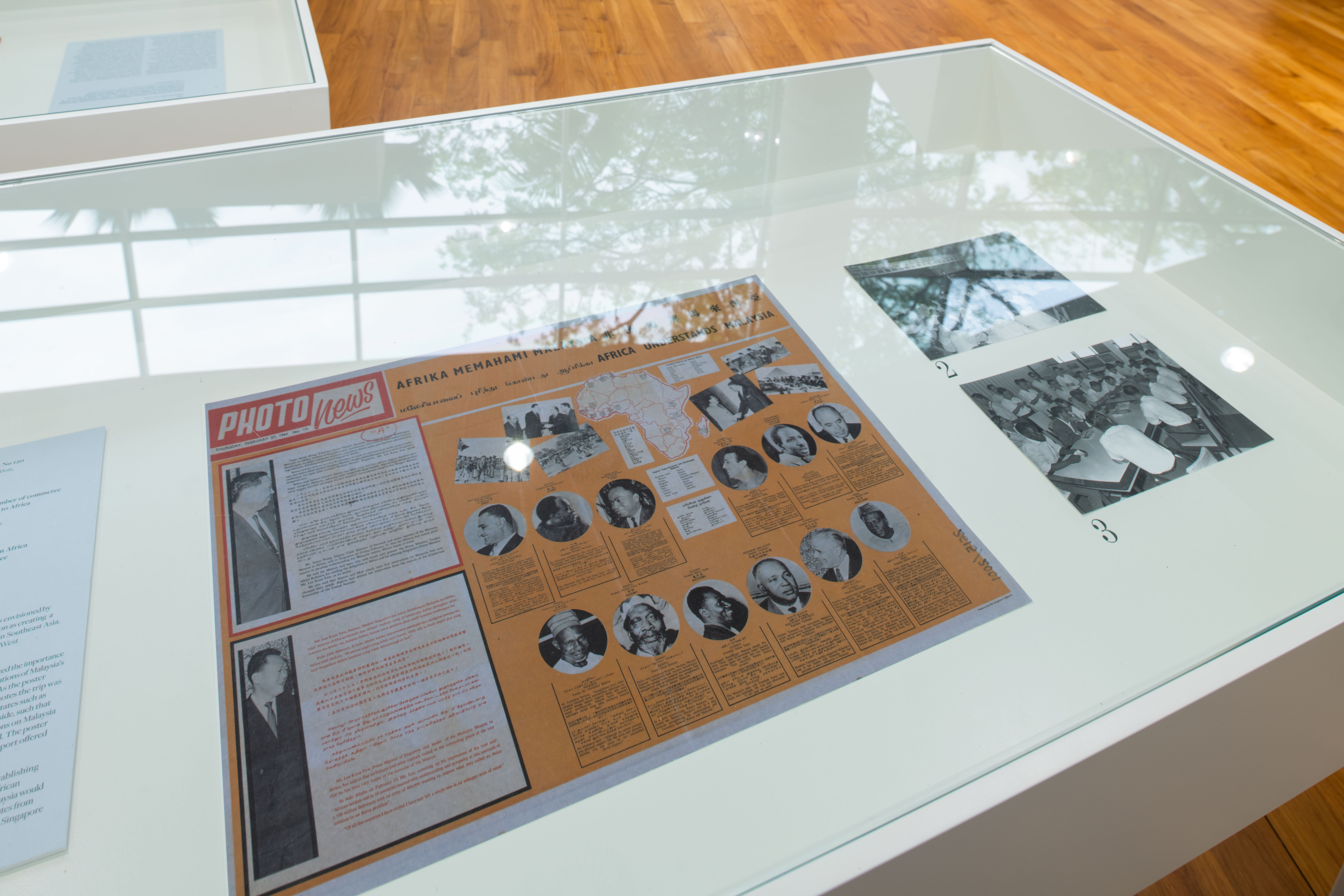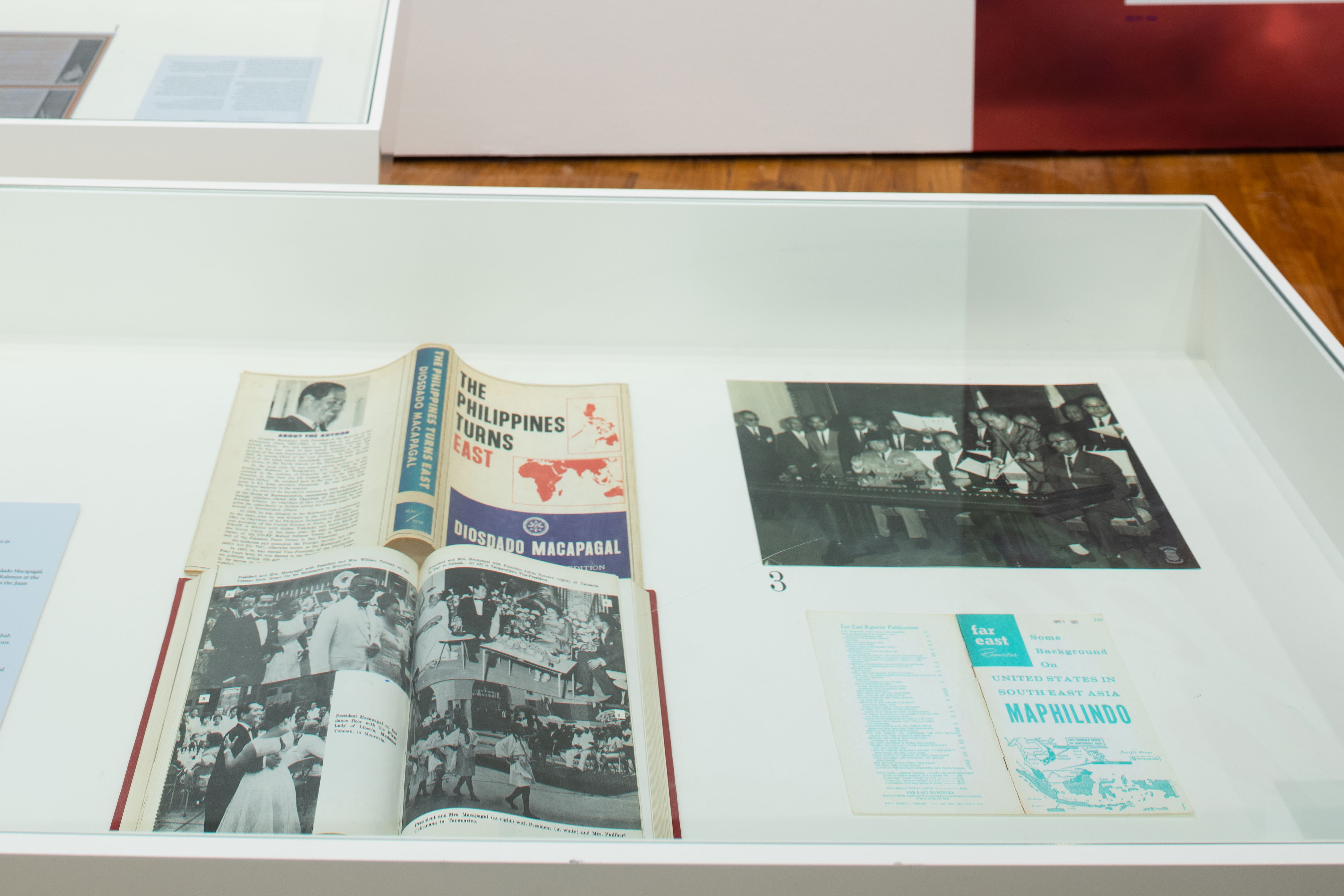
Portrait of Huey Newton, Black Panther
Party's founder and Minister of Defense,
seated on a peacock chair
1967
Reproduction
45.7cm x 30.5cm
The Peacock chair, also known as the Manila chair, is a single-seat chair with an oversized backrest that resembles a fully fanned peacock’s tail. It is made of rattan, a pliable reed harvested from a palm indigenous to the Malay world. It is woven into baskets and chairs, mostly as furniture for export. At some point it was known as “manila,” after the Philippine capital where perhaps most of rattan furniture comes from. One account historicizes the production of the chair within the penitentiary system of the Philippines with jailed criminals being tasked to weave home furnishings. In this iconic portrait taken in 1967, Black Panther Party founder and Minister of Defense Huey Newton is seen seated on a Peacock chair. The Black Panther Party is an anti-police brutality political organization led by African American students and founded in 1966 in Oakland. He is framed on either side by what annotators have identified as “traditional African shields.” There is a zebra carpet on the floor. In his right hand he holds a rifle, on his left is a spear. The chair resembles a throne, his gait regal, the objects surrounding him evoking power and violence. The Peacock chair participates in this iconography that recalls conventional representations of African culture—at once regal and unfamiliar, exotic.

Book display at National Library featuring books about Africa, including titles such as Africa in the United Nations; Handbook of African Affairs; The African Presence in World Affairs; Kenya a Political History the Colonial Period; The Mind of Africa; Democracy in Africa; and Africa and World Order
29 October 1965
Ministry of Information and the Arts Collection, courtesy of National Archives of Singapore
20.3cm x 13.5cm

A Letter from P. Ramlee on Pustaka Maphilindo
Filem Malaysia
1964
Private Collection of Wong Han Min
29.7cm x 21cm
Presented alongside Huey Newton’s famous portrait, these two objects speak to cultural resonances that the international and regional imaginary of solidarity had upon ‘everyday’ life. The 1965 book display from the National Library speaks to a general interest and awareness of Africa and its postcolonial independent projects in Singapore. While the letter by Malaysian filmmaker P. Ramlee (1929-1973) about his relationship to the Maphilindo Library and its relationship to the Filem Malaysia magazine speaks to how Maphilindo as an idea inspired and was navigated by cultural producers at the time.
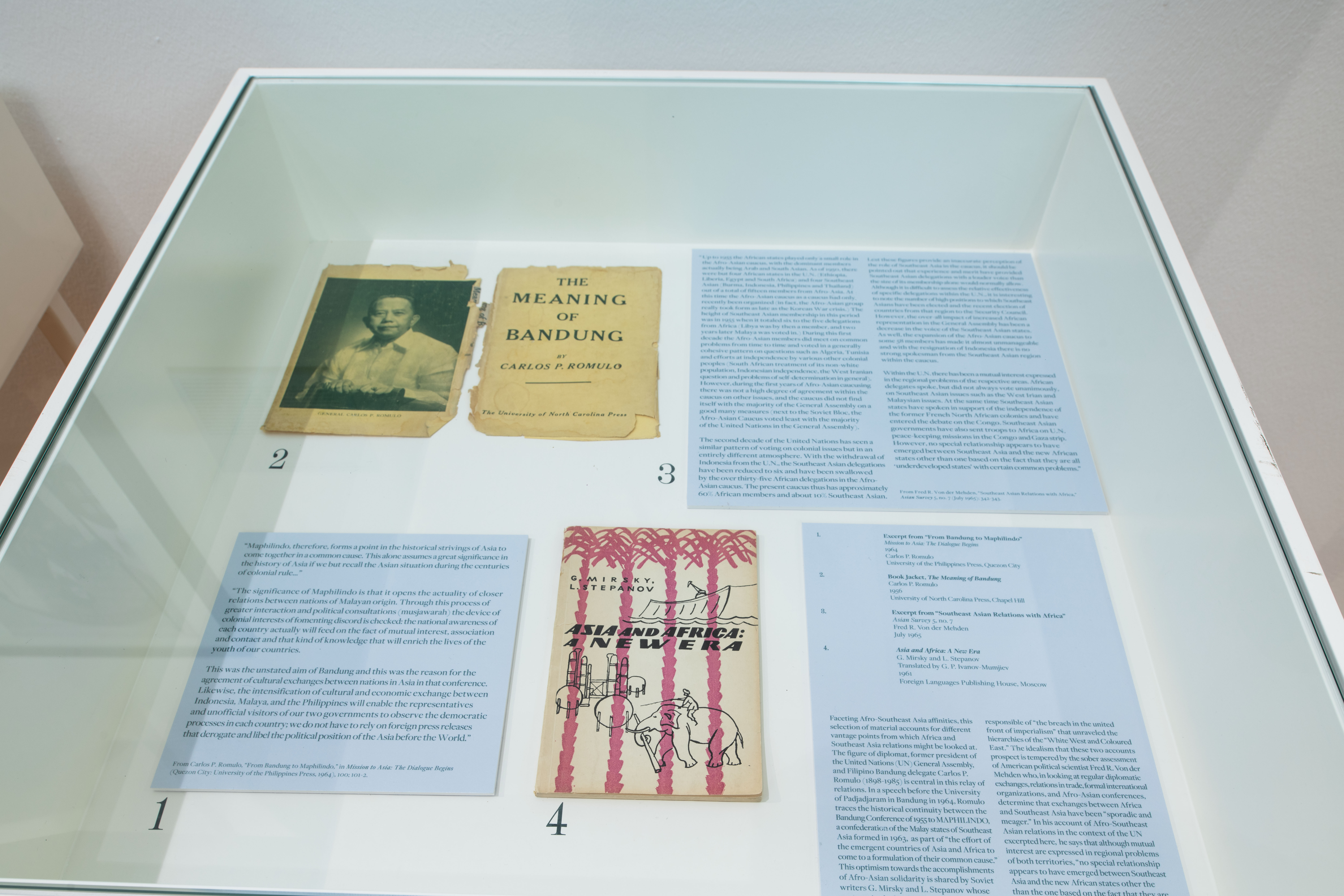
1. Excerpt from “From Bandung to Maphilindo”
Mission to Asia: The Dialogue Begins
1964
Carlos P. Romulo
University of the Philippines Press
Quezon City
Mission to Asia: The Dialogue Begins
1964
Carlos P. Romulo
University of the Philippines Press
Quezon City
2. Book Jacket, The Meaning of Bandung
Carlos P. Romulo
1956
University of North Carolina Press
Chapel Hill
Carlos P. Romulo
1956
University of North Carolina Press
Chapel Hill
3. Excerpt from “Southeast Asian Relations with Africa”
Asian Survey 5, no. 7
Fred R. von der Mehden
July 1965
Asian Survey 5, no. 7
Fred R. von der Mehden
July 1965
4. Asia and Africa: A New Era
G. Mirsky and L. Stepanov
Translated by G. P. Ivanov-Mumjiev
1961
Foreign Languages Publishing House
Moscow
G. Mirsky and L. Stepanov
Translated by G. P. Ivanov-Mumjiev
1961
Foreign Languages Publishing House
Moscow
Faceting Afro-Southeast Asia affinities, this selection of material accounts for different vantage points from which Africa and Southeast Asia relations might be looked at. The figure of diplomat, former president of the United Nations (UN) General Assembly, and Filipino Bandung delegate Carlos P. Romulo (1898-1985) is central in this relay of relations. In a speech before the University of Padjadjaram in Bandung in 1964, Romulo traces the historical continuity between the Bandung Conference of 1955 to Maphilindo, a confederation of the Malay states of Southeast Asia formed in 1963, as part of “the effort of the emergent countries of Asia and Africa to come to a formulation of their common cause.” This optimism towards the accomplishments of Afro-Asian solidarity is shared by Soviet writers G. Mirsky and L. Stepanov whose account in the book Asia and Africa: A New Era imagines this along sharper ideological lines wherein Russia’s October Revolution is responsible of “the breach in the united front of imperialism” that unraveled the hierarchies of the “White West and Coloured East.”
The idealism that these two accounts prospect is tempered by the sober assessment of American political scientist Fred R. von der Mehden who, in looking at regular diplomatic exchanges, relations in trade, formal international organizations, and Afro-Asian conferences, determine that exchanges between Africa and Southeast Asia have been “sporadic and meager.” In his account of Afro-Southeast Asian relations in the context of the UN excerpted here, he says that although mutual interest are expressed in regional problems of both territories, “no special relationship appears to have emerged between Southeast Asia and the new African states other the than the one based on the fact that they are all ‘underdeveloped states’ with certain common problems.”
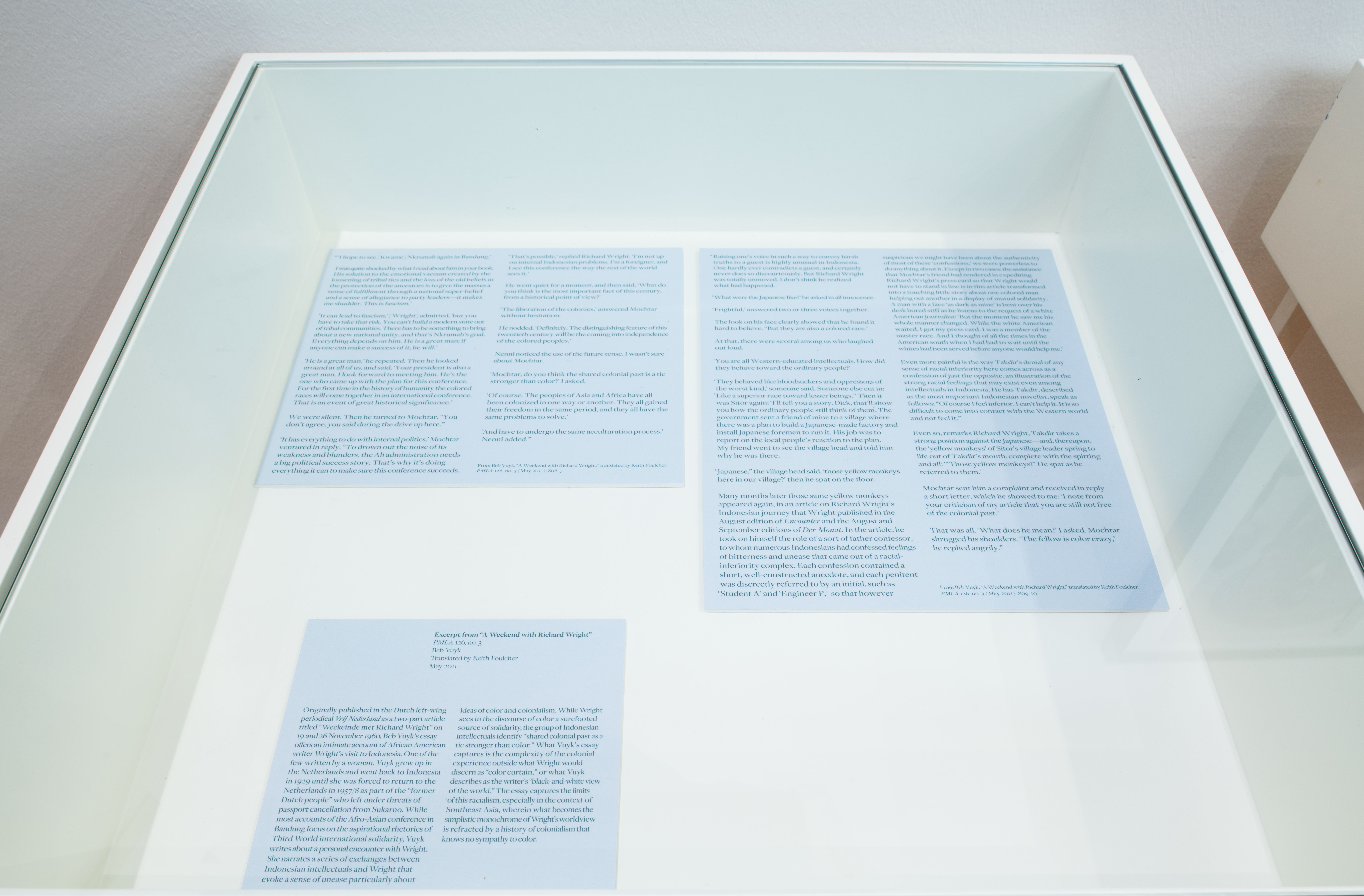
Excerpt from “A Weekend with Richard Wright”
PMLA 126, no. 3
Beb Vuyk
Translated by Keith Foulcher
May 2011
PMLA 126, no. 3
Beb Vuyk
Translated by Keith Foulcher
May 2011
Originally published in the Dutch left-wing periodical Vrij Nederland as a two-part article titled “Weekeinde met Richard Wright” on 19 and 26 November 1960, Beb Vuyk’s essay offers an intimate account of African American writer Wright’s visit to Indonesia. One of the few written by a woman. Vuyk grew up in the Netherlands and went back to Indonesia in 1929 until she was forced to return to the Netherlands in 1957/8 as part of the “former Dutch people” who left under threats of passport cancellation from Sukarno. While most accounts of the Afro-Asian conference in Bandung focus on the aspirational rhetorics of Third World international solidarity, Vuyk writes about a personal encounter with Wright. She narrates a series of exchanges between Indonesian intellectuals and Wright that evoke a sense of unease particularly about ideas of colour and colonialism.
While Wright sees in the discourse of colour a surefooted source of solidarity, the group of Indonesian intellectuals identify “shared colonial past as a tie stronger than color.” What Vuyk’s essay captures is the complexity of the colonial experience outside what Wright would discern as “color curtain,” or what Vuyk describes as the writer’s “black-and-white view of the world.” The essay captures the limits of this racialism, especially in the context of Southeast Asia, wherein what becomes the simplistic monochrome of Wright’s worldview is refracted by a history of colonialism that knows no sympathy to colour.
1. Africa Understands Malaysia
Photo News
Thursday, 27 February 1964, No. 120
Ministry of Information and the Arts Collection,
Courtesy of National Archives of Singapore
Accession No. PO2615/2001
50cm x 33.3cm
2. Guests attending a dinner hosted
by the chamber of commerce in honour
of the successful goodwill mission to Africa
1964
Ministry of Information and the Arts Collection,
Courtesy of National Archives of Singapore
20.3cm x 13.5cm
Photo News
Thursday, 27 February 1964, No. 120
Ministry of Information and the Arts Collection,
Courtesy of National Archives of Singapore
Accession No. PO2615/2001
50cm x 33.3cm
2. Guests attending a dinner hosted
by the chamber of commerce in honour
of the successful goodwill mission to Africa
1964
Ministry of Information and the Arts Collection,
Courtesy of National Archives of Singapore
20.3cm x 13.5cm
3. National Trade Union Congress- Delegates from
Africa calling on Minister of Finance
Dr. Goh Keng Swee
5 April 1964
Ministry of Information and the Arts Collection,
Courtesy of National Archives of Singapore
20.3cm x 13.5cm
Africa calling on Minister of Finance
Dr. Goh Keng Swee
5 April 1964
Ministry of Information and the Arts Collection,
Courtesy of National Archives of Singapore
20.3cm x 13.5cm
From 21 January to 27 February 1964, Singapore’s Prime Minister Lee Kuan Yew, having been selected by Malaysia’s Prime Minister, Tengku Abdul Rahman, led a 12-member delegation comprising Chief Ministers of Sarawak and Sabah and other ministers on the Malaysia Mission to Africa. They visited 17 African states (including Egypt, Tunisia, Mali, Guinea, Ghana, Nigeria, Kenya, Tanganyika and Madagascar) to explain the formation of Malaysia and its conflict with Indonesia. Maphilindo was in part based on a critique of the formation of Malaysia being a neocolonial British ploy.
Scholars such as Andrea Benvenuti and Wen-Qing Ngoei, have respectively explained that the formation of the federation of Malaysia, with Malaya absorbing Singapore and the British territories of Sabah and Sarawak, benefited the British by cost effectively providing access to military facilities in Singapore and by allaying fears that Singapore might slip into communism. Ngoei, in particular, has pointed out that the formation of Malaysia was envisioned by the Kennedy administration as creating a ‘wide anticommunist arc’ in Southeast Asia, the foundations for “a pro-West regional organisation.”
The Malaysia Mission evidenced the importance of the affirmation of African nations of Malaysia’s federation-building project. As the poster Africa Understands Malaysia notes the trip was successful in turning African states such as Algeria and Mali to Malaysia’s side, such that Algeria rescinded its reservations on Malaysia from the United Nations record. The poster notes the different words of support offered by African Nations.
The trip was also valuable in establishing relations between Malaysia and African nations. Following the mission, Malaysia would make more trips to Africa and delegates from African nations would also travel to Singapore and Malaysia.
Malaysian Solidarity Week in Sabah
18 November 1964
17 seconds
Copyright Reuters Limited.
All rights reserved.
This newsreel footage shows Sabah’s then Chief Minister Dato Donald Stephens inaugurating an exhibition organised as part of Malaysian Solidarity Week in Sabah in 1964. The exhibition showcased the racial diversity of Malaysia and presented some fifty photographs of captured Indonesian insurgents, displayed alongside their jungle uniforms and other paraphernalia. In a speech related to this event, Dato Donald Stephens notes that the Solidarity Week was held to show the world that despite Malaysia being composed of different races, he sees no difference in colour and creed. He instead finds community in how people gathered to pledge loyalty to Malaysia. As part of the Solidarity Week, a crowd of 15,000 people gathered outside the exhibition venue, bearing banners and placards in protest of Sukarno’s Konfrontasi doctrine and against Macapagal’s claims to Sabah territory. State offices closed early so that employees could attend the protest.
1. The Philippines Turns East
Diosdado Macapagal
1966
MAC Publishing House
Quezon City
2. Indonesian President Sukarno, Philippine
President Diosdado Macapagal, and Federation of
Malaya Prime Minister Tunku Abdul Rahman at
the formalization of Maphilindo on 5 August
1963, held at the Juan Luna Hall of the Department
of Foreign Affairs in Manila
Courtesy of the Official Gazette and the
National Library of the Philippines
Diosdado Macapagal
1966
MAC Publishing House
Quezon City
2. Indonesian President Sukarno, Philippine
President Diosdado Macapagal, and Federation of
Malaya Prime Minister Tunku Abdul Rahman at
the formalization of Maphilindo on 5 August
1963, held at the Juan Luna Hall of the Department
of Foreign Affairs in Manila
Courtesy of the Official Gazette and the
National Library of the Philippines
3. Far East Reporter: Some Background on
United States in South East Asia: Maphilindo
1965
Maud Russell
New York
United States in South East Asia: Maphilindo
1965
Maud Russell
New York
The year 1963 was an exceptional moment for the consolidation of discourses surrounding pan-Malayan political imaginations. In January 1963, Philippine Vice President Emmanuel Pelaez went to London and met with officials of the United Kingdom to discuss claims to Sabah, which was then part of the British colony. In August 1963, Maphilindo, a pan-Malayan confederation composed of then Malaya, the Philippines, and Indonesia, was formalized. The confederation proved short-lived as Indonesian President Sukarno rallied against the establishment of the Federation of Malaysia, which for him was a strategic neo-colonial ploy by the British to ensure their influence in the region. In December 1963, after a trip to the United States for the memorial of John F. Kennedy, Philippine President Diosdado Macapagal visited Libya, Tanganyika (part of present day Tanzania), Madagascar, and Kenya as a gesture of goodwill and a strategy to field for votes should the Philippine claim to Sabah prosper in the tribunal of the United Nations.
These moments sketch out the intricate entanglements of claims to pan-Malayan solidarity in the context of neo-colonial anxieties and geopolitical pressures. An editorial written by Jose Ma. Sison, founder of the Communist Party of the Philippines, reviews the rhetorics that inform the establishing of Maphilindo. Titled “MAPHILINDO: Afro-Asian or Anglo-American?” and published in the Far East Reporter: Some Background on United States in South East Asia: Maphilindo in 1965, the essay annotates the stakes of each party in the success of a Malayan confederation. For Sison, Maphilindo had the possibility of becoming an Afro-Asian anti-imperialist instrument or an Anglo-American method to force Indonesia into a trap with two Anglo- American client nations (the Philippines and Malaysia) effectively dampening its non-aligned and anti-imperial leverage.
To read more about Macapagal’s trip to Africa and his other writings relating to the formation of Maphilindo and the Sabah questions, click here.
Diosdado Macapagal, “Report on United States and Africa Trip,” in Fullness of Freedom: Speeches and Statements of President Diosdado Macapagal, vol. IV (Manila: Bureau of Printing, 1965), 152-65.
Diosdado Macapagal, “Towards a Common Destiny,” in Fullness of Freedom: Speeches and Statements of President Diosdado Macapagal, vol. IV (Manila: Bureau of Printing, 1965), 136-42.
Diosdado Macapagal, “Our Sabah,” The Philippines Turns East, 2nd ed. (Quezon City: Mac Publishing House, 1970 [1966]), 16-30.
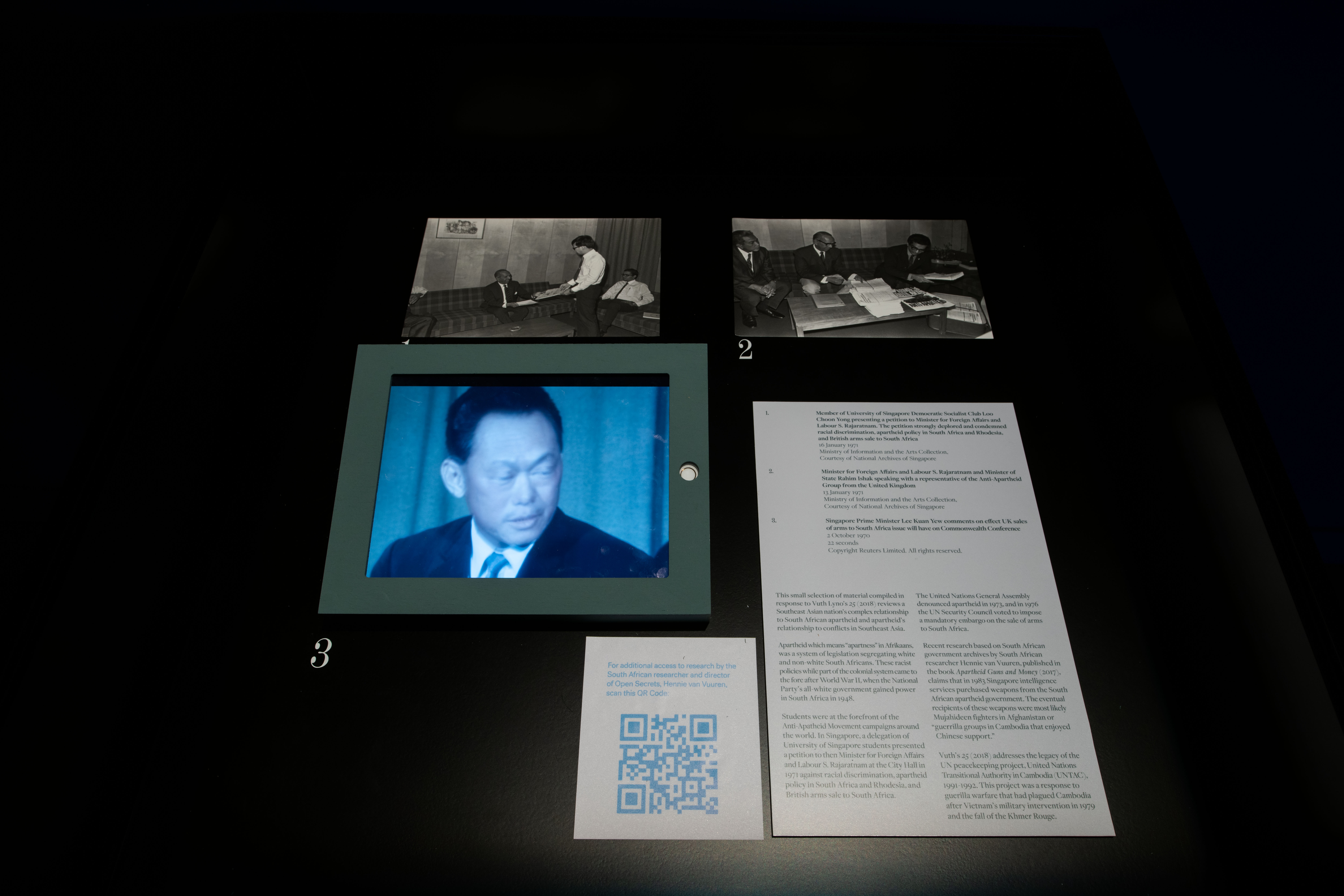
1. Member of University of Singapore Democratic
Socialist Club Loo Choon Yong presenting a
petition to Minister for Foreign Affairs and Labour
S Rajaratnam. The petition strongly deplored and
condemned racial discrimination, apartheid policy
in South Africa and Rhodesia, and British arms
sale to South Africa.
16 January 1971
Ministry of Information and the Arts Collection,
Courtesy of National Archives of Singapore
2. Minister for Foreign Affairs and Labour
S. Rajaratnam and Minister of State Rahim Ishak
speakin with a representative of the Anti-
Apartheid Group from the United Kingdom.
13 January 1971
Ministry of Information and the Arts Collection,
Courtesy of National Archives of Singapore
Socialist Club Loo Choon Yong presenting a
petition to Minister for Foreign Affairs and Labour
S Rajaratnam. The petition strongly deplored and
condemned racial discrimination, apartheid policy
in South Africa and Rhodesia, and British arms
sale to South Africa.
16 January 1971
Ministry of Information and the Arts Collection,
Courtesy of National Archives of Singapore
2. Minister for Foreign Affairs and Labour
S. Rajaratnam and Minister of State Rahim Ishak
speakin with a representative of the Anti-
Apartheid Group from the United Kingdom.
13 January 1971
Ministry of Information and the Arts Collection,
Courtesy of National Archives of Singapore
3. Singapore Prime Minister Lee Kuan Yew
comments on effect UK Sales of arms to South
Africa issue will have on Commonwealth
Conference in response to British journalist’s
question of whether African nations will walk
out of the conference
2 October 1970
22 seconds
Copyright Reuters Limited.
All rights reserved.
comments on effect UK Sales of arms to South
Africa issue will have on Commonwealth
Conference in response to British journalist’s
question of whether African nations will walk
out of the conference
2 October 1970
22 seconds
Copyright Reuters Limited.
All rights reserved.
This small selection of material compiled in response to Vuth Lyno’s 25 (2018) reviews a Southeast Asian nation’s complex relationship to South African apartheid and apartheid’s relationship to conflicts in Southeast Asia. Apartheid which means “apartness” in Afrikaans, was a system of legislation segregating white and non-white South Africans. These racist policies while part of the colonial system came to the fore after World War II, when the National Party’s all-white government gained power in South Africa in 1948. Students were at the forefront of the Anti-Apatheid Movement campaigns around the world. In Singapore, a delegation of University of Singapore students presented a petition to then Minister for Foreign Affairs and Labour S. Rajaratnam at the City Hall in 1971 against racial discrimination, apartheid policy in South Africa and Rhodesia, and British arms sale to South Africa.
The United Nations General Assembly denounced apartheid in 1973, and in 1976 the UN Security Council voted to impose a mandatory embargo on the sale of arms to South Africa. Recent research based on South African government archives by South African researcher Hennie van Vuuren, published in the book Apartheid Guns and Money (2017), claims that in 1983 Singapore intelligence services purchased weapons from the South African apartheid government.
For additional access to research by Hennie van Vuuren, a South African researcher and director of Open Secrets, click here.
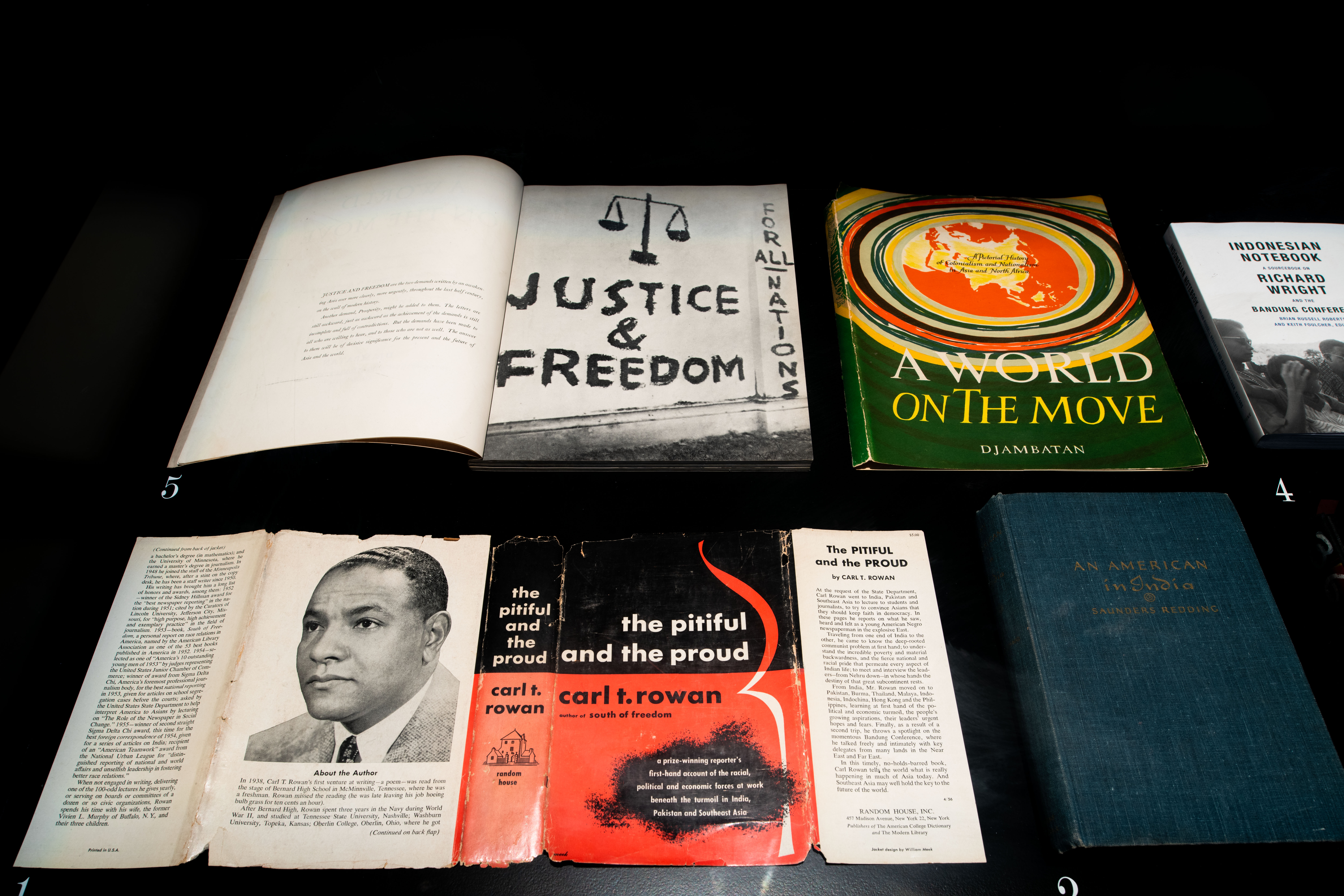
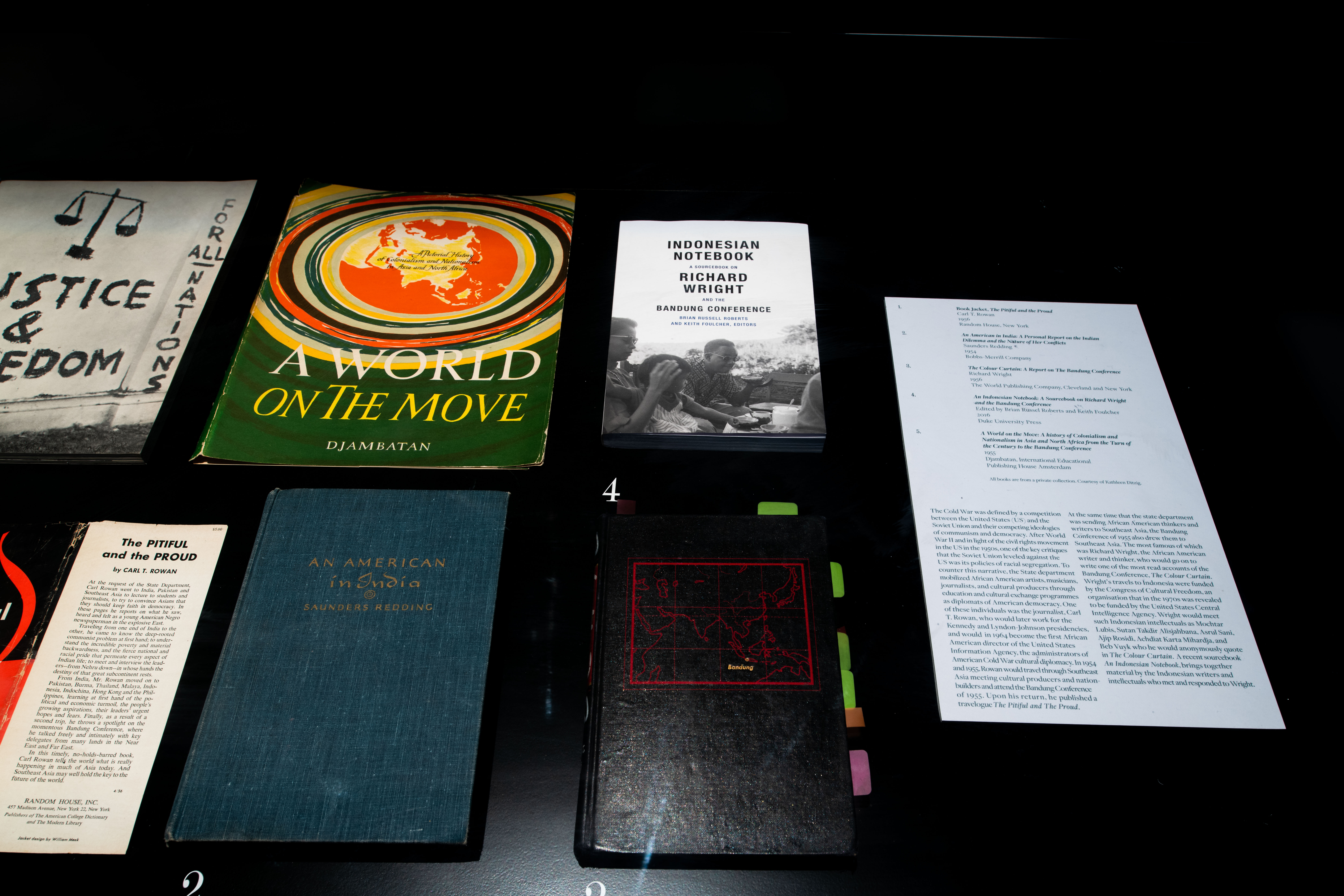
1. Book Jacket, The Pitiful and the Proud
Carl T. Rowan
1956
Random House, New York
2. A World on the Move: A history of Colonialism and
Nationalism in Asia and North Africa from the Turn
of the Century to the Bandung Conference
1955
Djambatan, International Educational Publishing House
Amsterdam
3. The Color Curtain: A Report on
The Bandung Conference
Richard Wright
1956
The World Publishing Company
Cleveland and New York
Carl T. Rowan
1956
Random House, New York
2. A World on the Move: A history of Colonialism and
Nationalism in Asia and North Africa from the Turn
of the Century to the Bandung Conference
1955
Djambatan, International Educational Publishing House
Amsterdam
3. The Color Curtain: A Report on
The Bandung Conference
Richard Wright
1956
The World Publishing Company
Cleveland and New York
4. An Indonesian Notebook:
A Sourcebook on Richard Wright and
the Bandung Conference
Edited by Brian Russel Roberts and Keith Foulcher
2016
Duke University Press
5. An American in India: A Personal Report on the
Indian Dilemma and the Nature of Her Conflicts
Saunders Redding
1954
Bobbs-Merrill Company
A Sourcebook on Richard Wright and
the Bandung Conference
Edited by Brian Russel Roberts and Keith Foulcher
2016
Duke University Press
5. An American in India: A Personal Report on the
Indian Dilemma and the Nature of Her Conflicts
Saunders Redding
1954
Bobbs-Merrill Company
